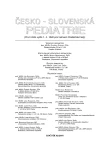Program of Hematopoietic Stem Cell Transplantation in Children at Department of Pediatric Hematology and Oncology, University Hospital Motol – from Fetal Liver to Cord Blood
Program transplantací kmenových buněk krvetvorby u dětí na Klinice dětské hematologie a onkologie FN Motol – od fetálních jater k pupečníkové krvi
Cíl:
Transplantací kmenových buněk krvetvorby (SCT) od zdravého dárce lze vyléčit řadu maligních i nemaligních onemocnění. V této práci autoři hodnotí výsledky alogenních SCT u dětí v období XI/1989 – XII/2005. V jednotlivých etapách sledují výsledky přežití, úmrtnost v důsledku relapsu malignity či toxicity výkonu, změny v použití dárců a druhů štěpů.
Soubor pacientů:
V letech 1989–2005 autoři na dětské transplantační jednotce ve FN v Motole provedli první SCT u 265 pacientů ve věku 0,2–20,5 roků (medián 9,7). 71 % (n = 189) pacientů bylo transplantováno pro maligní onemocnění krvetvorby (akutní leukémie, myelodysplastický syndrom, chronická myeloidní leukémie, lymfom apod.), ostatní pro nemaligní onemocnění (závažné vrozené a získané poruchy krvetvorby, těžká imunodeficience, osteopetróza, mukopolysacharidóza I. typu, adrenoleukodystrofie apod.). Dárcem štěpu byl v prvních letech převážně identický sourozenec (81 %), štěpem byla většinou kostní dřeň (93 %). V posledním období mezi dárci převažuje nepříbuzenský dárce (68 %), kostní dřeň je zdrojem kmenových buněk v 58 %.
Výsledky:
Z celkem 265 transplantovaných žije 165 pacientů (62 %). Přežití je vyšší ve skupině pacientů s nemaligním onemocněním (80 % versus 55 %). V průběhu let došlo k významnému snížení úmrtnosti v důsledku transplantačních komplikací z 29 % na 9 % a k významnému zlepšení přežívání ze 46 % na 80 %.
Závěry:
Alogenní SCT se na pracovišti autorů v průběhu let stala rutinní metodou v léčbě pokročilých forem leukémií a některých život ohrožujících nemaligních onemocnění pro děti z celé České republiky. Transplantace je pro takové děti zpravidla
poslední šancí na vyléčení.
Klíčová slova:
pediatrie, alogenní transplantace, kmenové buňky krvetvorby, fetální játra, pupečníková krev, alternativní dárci
Authors:
P. Sedláček 1; R. Formánková 1; P. Keslová 1; E. Mejstříková 1; P. Kobylka 2; A. Hrubá 2; I. Fales 2; Š. Rahmatová 2; Z. Sieglová 2; P. Hubáček 1; V. Vávra 1; L. Šrámková 1; V. Komrska 1; J. Trka 1; J. Starý 1
Authors‘ workplace:
Klinika dětské hematologie a onkologie UK 2. LF, FN Motol, Praha
přednosta prof. MUDr. J. Starý, DrSc.
1; Ústav hematologie a krevní transfuze, Praha
přednosta prof. MUDr. P. Klener, DrSc.
2
Published in:
Čes-slov Pediat 2007; 62 (9): 510-518.
Category:
Original Papers
Overview
Objectives:
Transplantation of allogeneic stem cells from healthy donor can cure several malignant and non-malignant disorders in children. In this paper authors evaluate results of allogeneic SCT (stem cell transplantation) in children performed at transplant center from November, 1989, to December, 2005. At certain time points they determine survival rates, death rates due to toxicity or relapse of malignancy, changes in donors and grafts composition.
Patients and methods:
From 1989 till 2005 altogether 265 patients at the age of 0.2–20.5 years (median 9.7) underwent first allogeneic SCT at transplant unit (Teaching Hospital Motol, Prague). 71% (n=189) were transplanted for malignant disease (acute leukemia, myelodysplastic syndrome, chronic myelogenous leukemia, lymphoma, etc.), other for life-threatening non-malignant disorder (congenital or acquired bone marrow failure, severe immunodeficiency, osteopetrosis, mucopolysaccharidosis type I., adrenoleukodystrophy, etc.). At the beginning matched sibling donors were predominantly used (81%). Bone marrow was used as a source of stem cells in majority of patients (93%). Over last period authors use more frequently graft obtained from unrelated donor (68%), bone marrow is currently used in only 58% of transplants.
Results:
Out of 265 transplanted patients 165 (62%) survive. The survival is higher in the group of children transplanted for non-malignant disorder (80% versus 55%). Over the time the authors successfully reduced overall transplant related mortality from 29% to 9%. Survival rate improved markedly from 46% (1989–2000) to 80% (2001–2005).
Conclusions:
Allogeneic SCT at the transplant unit over the passed years became a standard procedure in the therapy of advanced stages of malignant diseases or some life-threatening non-malignant disorders for children from all the Czech Republic. For such children transplantation represents the last chance to be cured. Even with majority of transplants being done using grafts from alternative donors, the authors achieve the same excellent results as they do in outstanding European pediatric transplant centers.
Key words:
pediatrics, allogeneic transplantation, hematopoietic stem cell, fetal liver, cord blood, alternative donors
Labels
Neonatology Paediatrics General practitioner for children and adolescentsArticle was published in
Czech-Slovak Pediatrics

2007 Issue 9
- What Effect Can Be Expected from Limosilactobacillus reuteri in Mucositis and Peri-Implantitis?
- The Importance of Limosilactobacillus reuteri in Administration to Diabetics with Gingivitis
Most read in this issue
- Infection with Bacteria Pseudomonas aeruginosa in Patients with Cystic Fibrosis Diagnostics Possibilities and Clinical Outcomes of a Three-Year Study
- Disorders of Hemostasis in Newborns
- Unstable Hemoglobin Variants in Children of the Czech and Slovak Population
- Program of Hematopoietic Stem Cell Transplantation in Children at Department of Pediatric Hematology and Oncology, University Hospital Motol – from Fetal Liver to Cord Blood
